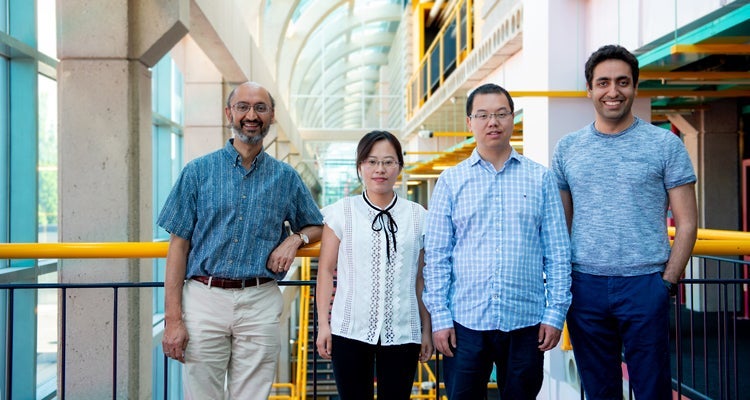Radio frequency identification (RFID) tags, those ribbons of metal with a tiny chip, are found in countless objects. From key fobs and payment cards to library books and inventory in a factory, these embedded inexpensive tags provide a way to uniquely and wirelessly identify objects.
“Over the past 10 years or so, many papers in the research literature have described new applications for RFIDs tags such as precise localization and tracking, orientation sensing, touch sensing, among others,” said Ju Wang, a postdoctoral fellow at the Cheriton School of Computer Science. “RFID tags are small, don’t require a battery and are inexpensive, so it would be great if we could do more with them. Many useful applications have been described in the literature, but in practice we found that few of them have been deployed widely.”

L to R: Professor Srinivasan Keshav, Liqiong Chang, Ju Wang and Professor Omid Abari
At first, the lack of real-world applications seemed puzzling, but the more Ju Wang and his colleagues Liqiong Chang and Professors Srinivasan Keshav and Omid Abari looked into RFID systems, the more they realized the problem is inherent in the properties of the radio signal the tag uses to communicate with a reader. In short, the properties of the tag’s radio signal — its phase and received strength — are easy to perturb, but these same signal properties are what many RFID systems use for communication and sensing.
“It’s all works fine in a lab or an experimental application, where everything is precisely controlled,” said Professor Omid Abari. But the moment a bit of randomness is introduced into the system, say a person standing between an RFID tag and the reader, or if an RFID tag have been moved, rotated or flexed, its radio characteristics — the strength and phase of the radio signal — can change dramatically.
“It’s a fundamental problem,” Professor Abari continued. “If something in the environment changes, the signal from the RFID tag changes, but how do you know if the tag is sensing something or if something in the environment has changed. This is why we think RFID tags have not been widely used for sensing applications.”
“Our research basically explored the troubles we encountered to get RFID tags to work reliably,” Ju Wang explained. “We found that you need to be careful about what signal features you’re using and you need to be careful which kind of tag you’re using. Some RFID tags are more robust but their range is quite limited. Other tags have greater range, but are less robust. It’s a tradeoff and we need to pay attention to them. Importantly, we also need to make the RFID systems more robust — to find and use aspects of the RFID’s radio signal that hold up in a variety of real-world applications.”
To learn more about this research, please see Ju Wang, Liqiong Chang, Omid Abari and Srinivasan Keshav, 2019, Are RFID Sensing Systems Ready for the Real World? In: 17th Annual International Conference on Mobile Systems, Applications, and Services (MobiSys ’19), June 17–21, 2019, Seoul, Republic of Korea. ACM. https://doi.org/10.1145/3307334.3326084